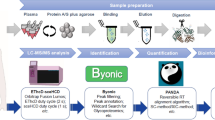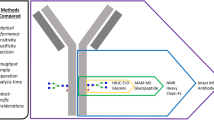Abstract
Glycoproteins secreted or expressed on the cell surface at specific pathophysiological stages are well-recognized disease biomarkers and therapeutic targets. While mapping of specific glycan structures can be performed at the level of released glycans, site-specific glycosylation and identification of specific protein carriers can only be determined by analysis of glycopeptides. A key enabling step in mass spectrometry (MS)-based glycoproteomics is the ability to selectively or non-selectively enrich for the glycopeptides from a total pool of a digested proteome for MS analysis since the highly heterogeneous glycopeptides are usually present at low abundance and ionize poorly compared with non-glycosylated peptides. Among the most common approaches for non-destructive and non-glycan-selective glycopeptide enrichment are strategies based on various forms of hydrophilic interaction liquid chromatography (HILIC). We present here a variation of this method using amine-derivatized Fe3O4 nanoparticles, in concert with in situ peptide N-glycosidase F digestion for direct matrix-assisted laser desorption/ionization–mass spectrometry analysis of N-glycosylation sites and the released glycans. Conditions were also optimized for efficient elution of the enriched glycopeptides from the nanoparticles for on-line nanoflow liquid chromatography–MS/MS analysis. Successful applications to single glycoproteins as well as total proteomic mixtures derived from biological fluids established the unrivaled practical versatility of this method, with enrichment efficiency comparable to other HILIC-based methods.






Similar content being viewed by others
Abbreviations
- Fuc:
-
Fucose
- Gal:
-
Galactose
- GlcNAc:
-
N-Acetylglucosamine
- Hex:
-
Hexose
- HexNAc:
-
N-Acetylhexosamine
- HILIC:
-
Hydrophilic interaction liquid chromatography
- MS:
-
Mass spectrometry
- Neu5Ac:
-
N-Acetylneuraminic acid
- ULF:
-
Uterine luminal fluid
References
Paulson JC, Blixt O, Collins BE (2006) Sweet spots in functional glycomics. Nat Chem Biol 2(5):238–248
Varki A (2008) Sialic acids in human health and disease. Trends Mol Med 14(8):351–360
Hakomori S (1996) Tumor malignancy defined by aberrant glycosylation and sphingo(glyco)lipid metabolism. Cancer Res 56(23):5309–5318
Zaia J (2010) Mass spectrometry and glycomics. OMICS 14(4):401–418
Hart GW, Copeland RJ (2010) Glycomics hits the big time. Cell 143(5):672–676
Pan S, Chen R, Aebersold R, Brentnall TA (2011) Mass spectrometry based glycoproteomics—from a proteomics perspective. Mol Cell Proteomics 10 (1):R110 003251
Wuhrer M, Catalina MI, Deelder AM, Hokke CH (2007) Glycoproteomics based on tandem mass spectrometry of glycopeptides. J Chromatogr 849(1–2):115–128
Madera M, Mechref Y, Klouckova I, Novotny MV (2007) High-sensitivity profiling of glycoproteins from human blood serum through multiple-lectin affinity chromatography and liquid chromatography/tandem mass spectrometry. J Chromatogr 845(1):121–137
Johansen E, Schilling B, Lerch M, Niles RK, Liu H, Li B, Allen S, Hall SC, Witkowska HE, Regnier FE, Gibson BW, Fisher SJ, Drake PM (2009) A lectin HPLC method to enrich selectively-glycosylated peptides from complex biological samples. J Vis Exp (32):1398
Zielinska DF, Gnad F, Wisniewski JR, Mann M (2010) Precision mapping of an in vivo N-glycoproteome reveals rigid topological and sequence constraints. Cell 141(5):897–907
Larsen MR, Jensen SS, Jakobsen LA, Heegaard NH (2007) Exploring the sialiome using titanium dioxide chromatography and mass spectrometry. Mol Cell Proteomics 6(10):1778–1787
Alvarez-Manilla G, Atwood J 3rd, Guo Y, Warren NL, Orlando R, Pierce M (2006) Tools for glycoproteomic analysis: size exclusion chromatography facilitates identification of tryptic glycopeptides with N-linked glycosylation sites. J Proteome Res 5(3):701–708
Snovida SI, Bodnar ED, Viner R, Saba J, Perreault H (2010) A simple cellulose column procedure for selective enrichment of glycopeptides and characterization by nano LC coupled with electron-transfer and high-energy collisional-dissociation tandem mass spectrometry. Carbohydr Res 345(6):792–801
Li J, Li X, Guo Z, Yu L, Zou L, Liang X (2011) Click maltose as an alternative to reverse phase material for desalting glycopeptides. Analyst 136(19):4075–4082
Wada Y, Tajiri M, Yoshida S (2004) Hydrophilic affinity isolation and MALDI multiple-stage tandem mass spectrometry of glycopeptides for glycoproteomics. Anal Chem 76(22):6560–6565
Wuhrer M, Koeleman CA, Hokke CH, Deelder AM (2005) Protein glycosylation analyzed by normal-phase nano-liquid chromatography–mass spectrometry of glycopeptides. Anal Chem 77(3):886–894
Takegawa Y, Deguchi K, Keira T, Ito H, Nakagawa H, Nishimura S (2006) Separation of isomeric 2-aminopyridine derivatized N-glycans and N-glycopeptides of human serum immunoglobulin G by using a zwitterionic type of hydrophilic-interaction chromatography. J Chromatogr A 1113(1–2):177–181
Mysling S, Palmisano G, Hojrup P, Thaysen-Andersen M (2010) Utilizing ion-pairing hydrophilic interaction chromatography solid phase extraction for efficient glycopeptide enrichment in glycoproteomics. Anal Chem 82(13):5598–5609
Parker BL, Palmisano G, Edwards AV, White MY, Engholm-Keller K, Lee A, Scott NE, Kolarich D, Hambly BD, Packer NH, Larsen MR, Cordwell SJ (2011) Quantitative N-linked glycoproteomics of myocardial ischemia and reperfusion injury reveals early remodeling in the extracellular environment. Mol Cell Proteomics 10 (8):M110 006833
Larsen MR, Hojrup P, Roepstorff P (2005) Characterization of gel-separated glycoproteins using two-step proteolytic digestion combined with sequential microcolumns and mass spectrometry. Mol Cell Proteomics 4(2):107–119
Alley WR Jr, Mechref Y, Novotny MV (2009) Use of activated graphitized carbon chips for liquid chromatography/mass spectrometric and tandem mass spectrometric analysis of tryptic glycopeptides. Rapid Commun Mass Spectrom 23(4):495–505
Hua S, Nwosu CC, Strum JS, Seipert RR, An HJ, Zivkovic AM, German JB, Lebrilla CB (2012) Site-specific protein glycosylation analysis with glycan isomer differentiation. Anal Bioanal Chem (in press)
Zhang H, Li XJ, Martin DB, Aebersold R (2003) Identification and quantification of N-linked glycoproteins using hydrazide chemistry, stable isotope labeling and mass spectrometry. Nat Biotechnol 21(6):660–666
Gao M, Deng C, Zhang X (2011) Magnetic nanoparticles-based digestion and enrichment methods in proteomics analysis. Expert Rev Proteomics 8(3):379–390
Sparbier K, Koch S, Kessler I, Wenzel T, Kostrzewa M (2005) Selective isolation of glycoproteins and glycopeptides for MALDI-TOF MS detection supported by magnetic particles. J Biomol Tech 16(4):407–413
Sparbier K, Asperger A, Resemann A, Kessler I, Koch S, Wenzel T, Stein G, Vorwerg L, Suckau D, Kostrzewa M (2007) Analysis of glycoproteins in human serum by means of glycospecific magnetic bead separation and LC-MALDI-TOF/TOF analysis with automated glycopeptide detection. J Biomol Tech 18(4):252–258
Lee YC, Block G, Chen H, Folch-Puy E, Foronjy R, Jalili R, Jendresen CB, Kimura M, Kraft E, Lindemose S, Lu J, McLain T, Nutt L, Ramon-Garcia S, Smith J, Spivak A, Wang ML, Zanic M, Lin SH (2008) One-step isolation of plasma membrane proteins using magnetic beads with immobilized concanavalin A. Protein Expr Purif 62(2):223–229
Chu ST, Huang HL, Chen JM, Chen YH (1996) Demonstration of a glycoprotein derived from the 24p3 gene in mouse uterine luminal fluid. Biochem J 316(Pt 2):545–550
Lin SY, Chen YY, Fan YY, Lin CW, Chen ST, Wang AH, Khoo KH (2008) Precise mapping of increased sialylation pattern and the expression of acute phase proteins accompanying murine tumor progression in BALB/c mouse by integrated sera proteomics and glycomics. J Proteome Res 7(8):3293–3303
Qhobosheane M, Santra S, Zhang P, Tan W (2001) Biochemically functionalized silica nanoparticles. Analyst 126(8):1274–1278
Bruce IJ, Sen T (2005) Surface modification of magnetic nanoparticles with alkoxysilanes and their application in magnetic bioseparations. Langmuir 21(15):7029–7035
Lee CL, Hsiao HH, Lin CW, Wu SP, Huang SY, Wu CY, Wang AH, Khoo KH (2003) Strategic shotgun proteomics approach for efficient construction of an expression map of targeted protein families in hepatoma cell lines. Proteomics 3(12):2472–2486
Dell A, Reason AJ, Khoo KH, Panico M, McDowell RA, Morris HR (1994) Mass spectrometry of carbohydrate-containing biopolymers. Methods Enzymol 230:108–132
Olsen JV, de Godoy LM, Li G, Macek B, Mortensen P, Pesch R, Makarov A, Lange O, Horning S, Mann M (2005) Parts per million mass accuracy on an orbitrap mass spectrometer via lock mass injection into a C-trap. Mol Cell Proteomics 4(12):2010–2021
Lee BS, Krishnanchettiar S, Lateef SS, Lateef NS, Gupta S (2005) Characterization of oligosaccharide moieties of intact glycoproteins by microwave-assisted partial acid hydrolysis and mass spectrometry. Rapid Commun Mass Spectrom 19(18):2629–2635
Yu SY, Wu SW, Hsiao HH, Khoo KH (2009) Enabling techniques and strategic workflow for sulfoglycomics based on mass spectrometry mapping and sequencing of permethylated sulfated glycans. Glycobiology 19(10):1136–1149
Kuo CW, Chen CM, Lee YC, Chu ST, Khoo KH (2009) Glycomics and proteomics analyses of mouse uterine luminal fluid revealed a predominance of Lewis Y and X epitopes on specific protein carriers. Mol Cell Proteomics 8(2):325–342
Calvano CD, Zambonin CG, Jensen ON (2008) Assessment of lectin and HILIC based enrichment protocols for characterization of serum glycoproteins by mass spectrometry. J Proteomics 71(3):304–317
McDonald CA, Yang JY, Marathe V, Yen TY, Macher BA (2009) Combining results from lectin affinity chromatography and glycocapture approaches substantially improves the coverage of the glycoproteome. Mol Cell Proteomics 8(2):287–301
Bodenmiller B, Mueller LN, Pedrioli PG, Pflieger D, Junger MA, Eng JK, Aebersold R, Tao WA (2007) An integrated chemical, mass spectrometric and computational strategy for (quantitative) phosphoproteomics: application to Drosophila melanogaster Kc167 cells. Mol Biosyst 3(4):275–286
Acknowledgments
This work was supported by Taiwan NSC grants 94-3112-B-001-009-Y and 95-3112-B-001-014 to the NRPGM Core Facilities for Proteomics located at the Institute of Biological Chemistry, Academia Sinica. The LTQ-Orbitrap data were additionally acquired at the Academia Sinica common mass spectrometry facilities, also at the Institute of Biological Chemistry. We are grateful to Dr. Sin-Tak Chu (Institute of Biochemical Sciences, National Taiwan University) for providing the mouse uterine luminal fluid samples.
Author information
Authors and Affiliations
Corresponding author
Electronic supplementary material
Below is the link to the electronic supplementary material.
ESM 1
(PDF 1.65 mb)
Rights and permissions
About this article
Cite this article
Kuo, CW., Wu, IL., Hsiao, HH. et al. Rapid glycopeptide enrichment and N-glycosylation site mapping strategies based on amine-functionalized magnetic nanoparticles. Anal Bioanal Chem 402, 2765–2776 (2012). https://doi.org/10.1007/s00216-012-5724-1
Received:
Revised:
Accepted:
Published:
Issue Date:
DOI: https://doi.org/10.1007/s00216-012-5724-1




